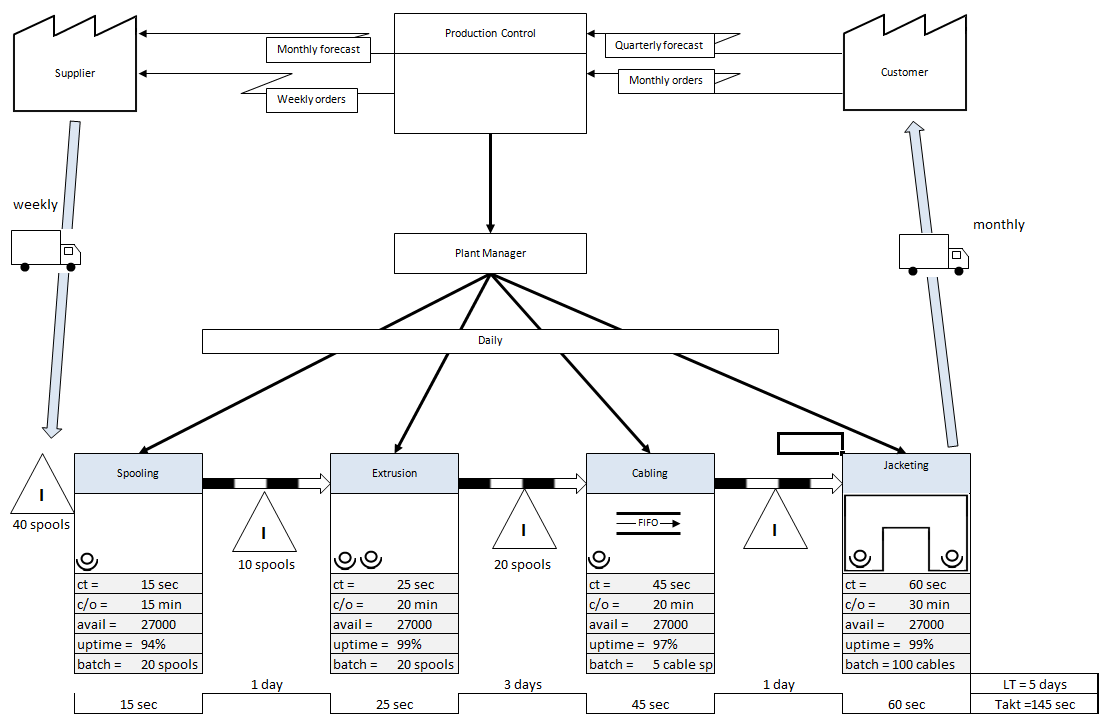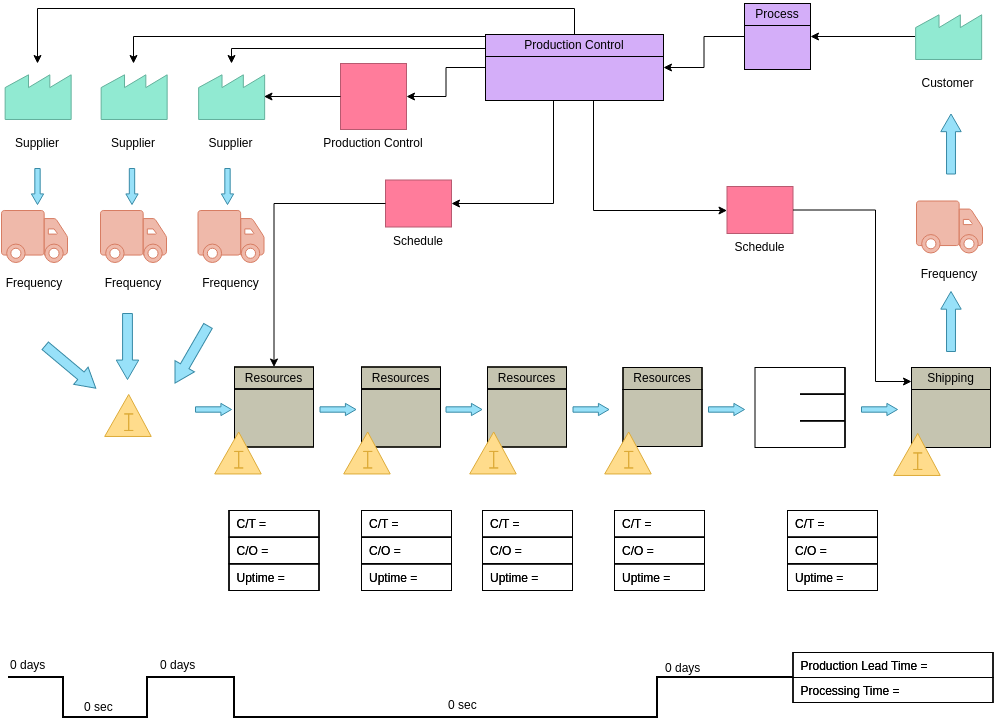- Type value stream map in the Search box, click the Start Searching button, and then double-click Value Stream Map when it appears. From the Value Stream Map Shapes stencil, drag shapes onto the page to represent your processes, information, and materials.
- Value stream mapping is a lean management tool that helps visualize the steps needed to take from product creation to delivering it to the end-customer. As with other business process mapping methods, it helps with introspection (understanding your business better), as well as analysis and process improvement.
- Free Value Stream Mapping Software Program
- Free Download Value Stream Mapping Software
- Free Value Stream Mapping Software Downloads
- Free Value Stream Mapping Software Online
- Free Value Stream Mapping Excel Template Software
DevOps is for everyone
Software is becoming increasingly integral to the operation of every business in every sector in every market. Therefore, almost every business today has become a de facto digital enterprise. And each is vulnerable to the disruptions caused by new competitors leveraging digital technology to quickly enter markets and overturn existing business models. The Scaled Agile Framework serves the business imperative of making organizations more agile in responding to digital disruption. The DevOps and Release on Demand competency’s focus on enabling the business to release on demand plays a key role in ensuring greater enterprise agility. It is a critical enabler for the ability to release on demand, because it helps overcome traditional misalignments across the Value Stream.
These value stream mapping templates are created using the standard symbols available in the Creately value stream mapping tool library. If you find the VSM templates that suit your requirements, simply click it to open it in the Creately editor; you can edit it as you want from there and download it as a PDF or an image (PNG, JPEG etc.).
Moving value through the enterprise
DevOps is a mindset, an enterprise-wide culture and practice. Although it does not have a commonly accepted manifesto or playbook, core capabilities of successful DevOps implementations can be identified. The five core concepts of DevOps and Release on Demand include:
- Value Stream Mapping
- Gaining alignment with Continuous Exploration (CE)
- Building quality in with Continuous Integration (CI)
- Reducing time-to-market with Continuous Deployment (CD)
- Delivering business value with release on demand
In SAFe DevOps, we also have a tool called the SAFe DevOps Health Radar. The health radar was built to help Agile Release Trains (ARTs) assess their ability to deliver continuous value to their customers. The assessment allows the ART to drill down into the 16 sub-dimensions of the Continuous Delivery Pipeline and rate their proficiency in more than 50 specific skills. After identifying gaps using the health radar, ARTs upskill in the areas that improve value flow the most and conduct periodic follow-up assessments to manage their ongoing improvement. The DevOps Health Radar is a popular, free tool that helps ARTs manage the long term evolution of their Continuous Delivery Pipelines.
You can also go to our partner’s site, AgilityHealth, to take an online version of the assessment at https://agilityhealthradar.com/safe-devops-assessment.
Value Stream Mapping
When implementing DevOps, the problem is that even after a good action plan is created, the team is not sure how to act on it or whether the right people are even working on it. Value Stream mapping is a multifaceted tool for identifying problems with the flow of value and building a better future map and action plan. This draws clarity to where the bottlenecks lie and where the improvements are most needed.
Build the Continuous Delivery Pipeline
Gaining alignment with continuous exploration
Continuous exploration is the process of continually exploring the market and user needs, as well as defining a Vision, Roadmap, Architecture, and set of Features that address these needs. CE helps to build alignment across the organization about what should be built or what hypothesis should be evaluated.
Building quality in with continuous integration


Stakeholders need to see work turning into tangible, working solutions. Continuous integration ensures that development teams are not only busy, but productive, by delivering working software and systems each Iteration. Without CI, teams may be sprinting, but the system as a whole might not be iterating.
Reducing time-to-market with continuous deployment
Enterprises deploy continuously to get to market quickly and enable the business to release value on demand. In SAFe, deployment is decoupled from release. Therefore, continuous deployment focuses on deploying continuously to production, not going live to end users.
Delivering business value with release on demand
Releasing value on demand provides the business with the capability of getting value into the hands of users when there is market and user demand for it. The final part of every hypothesis learning cycle is evaluating with customers and users, and learning for further exploration. Responsibility for operating the solution is shared across the organization.
A CALMR approach to DevOps
Approaches to implementing DevOps are diverse, without a standard playbook or central manifesto. But successful DevOps organizations do tend to have certain capabilities in common. They help inform the principles on which SAFe DevOps is based. SAFe calls these principles a CALMR approach to DevOps.
Culture

Establish a culture of shared responsibility for development, deployment, and operations.
Automation
Automate the continuous delivery pipeline.
Lean flow
Keep batch sizes small, limit WIP, and provide extreme visibility.
Measurement
Free Value Stream Mapping Software Program
Measure the flow through the pipeline. Implement application telemetry.

Free Download Value Stream Mapping Software
Recovery
Free Value Stream Mapping Software Downloads
Architect and enable low risk releases. Establish fast recovery, fast reversion, and fast fix-forward.
Ready to accelerate value delivery?
The core concepts of DevOps are tested, proven, and straightforward. But their successful application is based on learning new skills to help map an organization’s current value stream through its delivery pipeline from concept to cash. It is also critical to learn how to identify practices that will eliminate bottlenecks to flow. With the tide of digital disruption continuing to roll through every industry and enterprise, training in SAFe DevOps is growing in importance. Certification in these skills enables leadership to quickly assemble teams who can help the organization achieve greater agility.
SAFe DevOps training helps you…
- Explain how DevOps enables strategic business objectives
- Apply a CALMR approach to DevOps to avoid automating broken processes
- Understand how successful DevOps requires continuous exploration, continuous integration, continuous deployment, and the ability to release to end users on demand
- Incorporate continuous testing and continuous security into the delivery pipeline
- Use value stream mapping to measure flow and identify bottlenecks in the end-to-end delivery process
- Select DevOps skills and tools strategically for the fastest, most compelling results
- Prioritize DevOps solutions and investments for greatest economic benefit
- Design and implement a multi-phased DevOps transformation plan tailored to their organization
- Work with all roles and levels in the organization to continually optimize the value stream
Free Value Stream Mapping Software Online
Accelerate your DevOps understanding
Free Value Stream Mapping Excel Template Software
Scaled Agile partners offer two-day training courses privately at your location or in a public setting for anyone to attend. The course provides a comprehensive overview for understanding the DevOps and release on demand skills needed to accelerate time-to-market by improving the flow of value through the continuous delivery pipeline. Attending the class also unlocks access to the Scaled Agile Community and prepares students to take the exam and become a Certified SAFe® DevOps Practitioner.